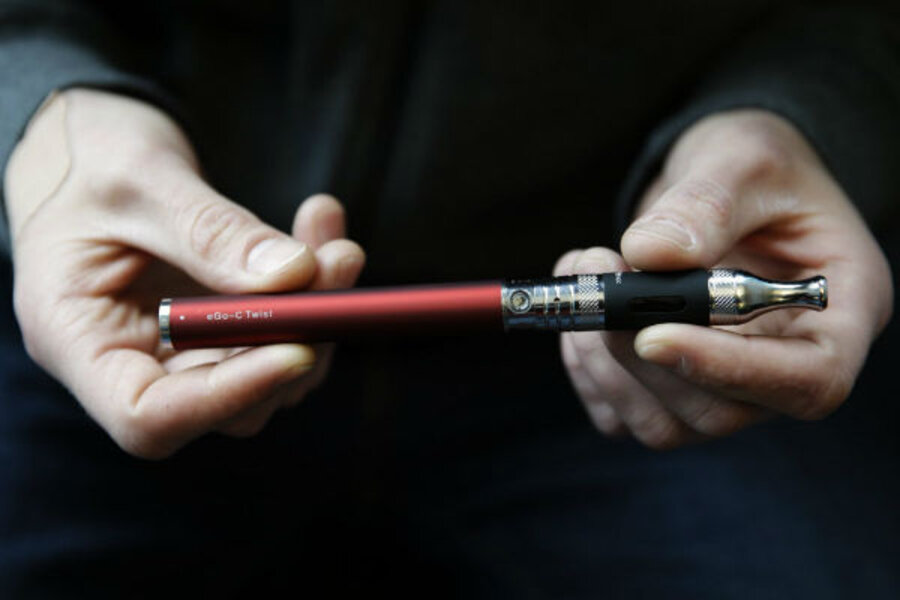E-cigarettes: what the FDA wants to regulate and what it doesn't
Loading...
An electronic cigarette looks like a cigarette, glows like a cigarette, and delivers nicotine like a cigarette, but in the eyes of the federal government, it doesn't yet fall under federal regulation of cigarettes. The Food and Drug Administration wants to change that.
The FDA on Thursday announced a proposal to extend its tobacco authority to include tobacco-derivative products, including e-cigarettes.
“This proposed rule is the latest step in our efforts to make the next generation tobacco-free,” outgoing Health and Human Services Secretary Kathleen Sebelius said in a statement.
Electronic cigarettes, commonly known as e-cigarettes, are plastic or metal cylinders that resemble cigarettes but that heat a liquid nicotine solution rather than burn tobacco. Although e-cigarettes do not contain tobacco, the nicotine is derived from tobacco.
Some smokers and public health experts see e-cigarettes as a valuable tool for people looking to quit smoking, because the e-cigarettes do not contain the thousands of added chemicals that are rolled into traditional cigarettes and because smokers can gradually reduce the concentration of the nicotine solution in an effort to wean themselves off the drug.
The FDA has not yet evaluated this issue. The Tobacco Control Act allows FDA to establish tobacco product standards that can include provisions for nicotine yields if such provisions are appropriate for the protection of the public health. However, the FDA website notes that this law "specifically states that FDA is prohibited from requiring the reduction of the nicotine yields of a tobacco product to zero."
Others worry that e-cigarettes may lure young people to develop a nicotine habit or even pose risks of nicotine overdose, as manually loaded versions allow the solution to be absorbed through the skin.
“I like to be optimistic and think that maybe it’s a good thing if smokers will adopt this instead of actually smoking,” says University of Pennsylvania researcher Dan Romer. “That’s a potentially nice scenario, but what about the people, including adolescents, who aren’t already addicted that might be tempted to develop a new habit.”
The FDA’s proposal mirrors many of the existing regulations for cigarettes and other tobacco products. The proposed regulations would:
- Require e-cigarette manufacturers to register with the FDA and report on products and ingredients.
- Prohibit the marketing of new tobacco products prior to FDA review.
- Restrict direct and implied claims of reduced risk until the FDA is able to confirm scientific evidence supporting those claims.
- Ban the distribution of free samples.
- Impose minimum age restrictions on the sale of electronic cigarettes, a step that at least 33 states, including Alabama, New York, Wyoming, and California, have already taken.
- Require health warnings on packaging similar to those included on traditional cigarettes.
- Prohibit the sale of electronic cigarettes and nicotine cartridges in vending machines.
The proposed regulations do not include restrictions on flavors that are added to the nicotine solution, despite the fact that flavored cigarettes have been banned since 2009. Many manufacturers currently offer candy-like flavors as well as more traditional tobacco and menthol flavors.
“The flavors do sound like a pitch to get adolescents to try it because flavoring will make it possible to ingest nicotine in a more pleasant way,” says Mr. Romer, director of the Adolescent Communication Institute at the University of Pennsylvania’s Annenberg Public Policy Center in Philadelphia.
Some marketing restrictions already exist. Companies can’t tout e-cigarettes as smoking cessation aids without falling under FDA guidelines for drug-delivery devices. The FDA has not yet indicated whether it is considering additional marketing restrictions to eliminate advertising on TV, radio, billboards, and sponsored merchandise.






